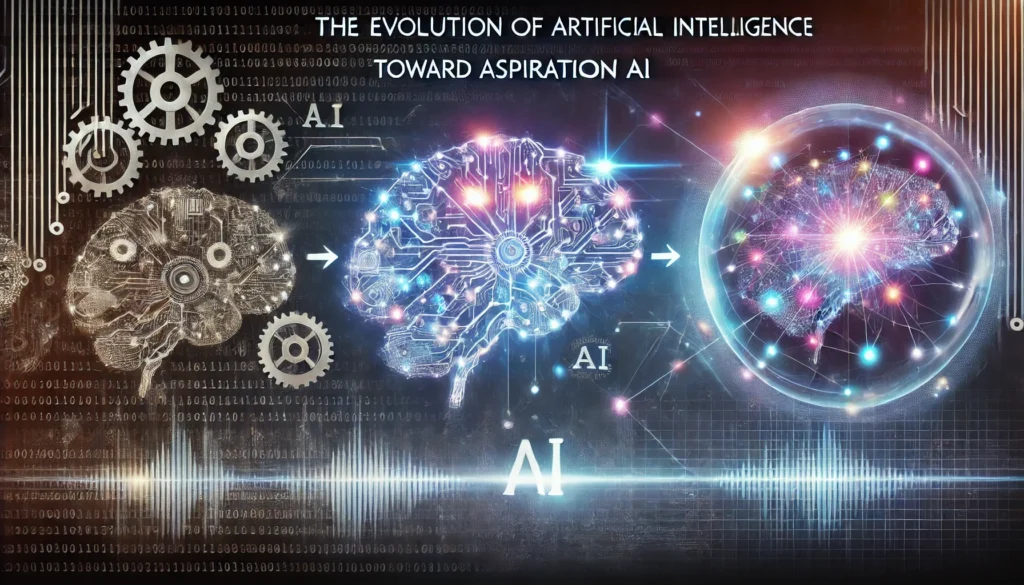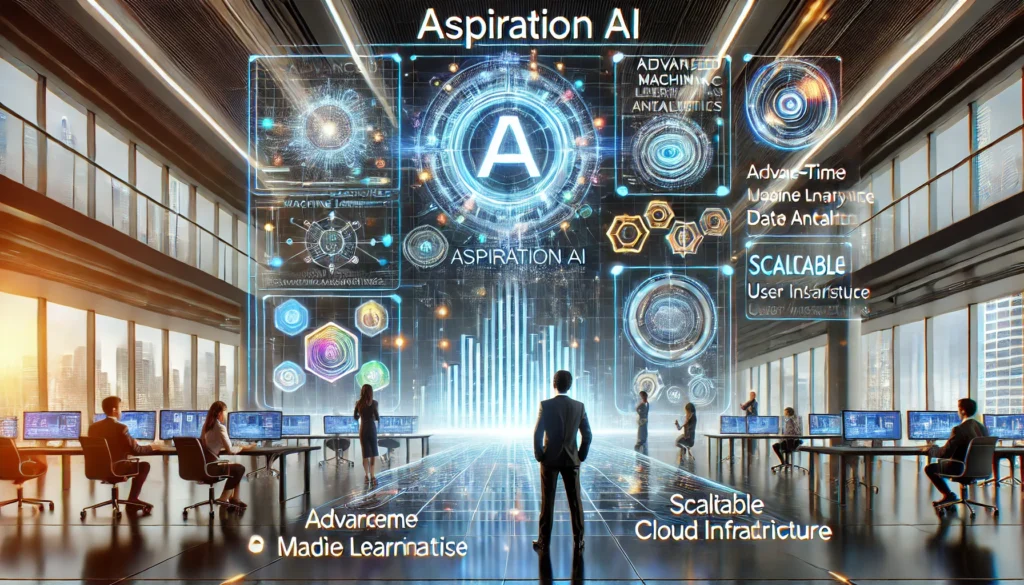Artificial Intelligence (AI) has already transformed how we live, work, and interact with technology, but Aspiration AI, a goal-oriented form of intelligence, is poised to take this evolution to the next level. Unlike traditional AI systems, which focus on automating specific tasks or learning from past data, Aspiration AI is designed to think proactively, set goals, and adapt dynamically to achieve them. In this comprehensive guide, we’ll delve into the mechanics, applications, and potential of Aspiration AI. By unlocking the essence of goal-oriented intelligence, we can better understand how this technology will reshape industries, revolutionize personal productivity, and address some of humanity’s most complex challenges.
Table of Contents
Introduction: What is Aspiration AI?
Aspiration AI is an emerging branch of artificial intelligence that emphasizes goal-directed behavior. It differs from traditional AI in its ability to focus on long-term objectives rather than just performing specific tasks. Think of it as an AI system equipped with “intent”—a set of ambitions or aspirations that guide its learning and decision-making processes. This type of intelligence can identify problems, formulate strategies, and adapt to changing environments, enabling it to not only meet predefined objectives but also redefine its goals as circumstances evolve. In a way, Aspiration AI brings machines closer to emulating human-like cognitive functions.
The Evolution of Artificial Intelligence Toward Aspiration AI

AI has come a long way since its inception. To fully grasp Aspiration AI, it’s crucial to understand the milestones that paved the way for this groundbreaking development:
1. Rule-Based Systems:
The earliest AI systems relied on rigid rules and logical reasoning to solve problems. These were effective for simple, repetitive tasks but lacked adaptability.
2. Machine Learning and Big Data:
The advent of machine learning allowed systems to analyze vast amounts of data, learn patterns, and make predictions. However, this approach required massive datasets and often lacked creativity.
3. Reinforcement Learning:
Reinforcement learning introduced a trial-and-error approach, enabling AI to learn from its actions and refine its strategies. This was a step closer to goal-oriented behavior.
4. The Emergence of Aspiration AI:
Combining elements of machine learning, natural language processing, and cognitive modeling, Aspiration AI builds on these foundations by adding the capability to set and pursue goals dynamically.
How Does Aspiration AI Work?
Aspiration AI operates through a multi-layered process that involves goal formation, decision-making, adaptation, and execution. Let’s break down these steps:
Goal Formation:
At the core of Aspiration AI is the ability to identify and prioritize objectives. This can range from solving a single problem to achieving complex, multi-step goals.
Dynamic Learning:
Unlike static systems, Aspiration AI learns continuously by monitoring its progress and adjusting its strategies based on outcomes and environmental changes.
Decision-Making Models:
These systems use advanced algorithms that simulate human decision-making processes, factoring in risks, constraints, and potential benefits.
Adaptability:
Aspiration AI excels in adapting to changing circumstances, ensuring that even if the original goal becomes unattainable, new objectives can be set.
Key Features of Aspiration AI
Aspiration AI stands out due to its innovative features, which include:
- Proactivity: The ability to anticipate challenges and take initiative without waiting for direct inputs.
- Self-Optimization: Continuous refinement of strategies to improve performance over time.
- Context Awareness: Understanding the broader environment to make informed decisions.
- Resilience: Maintaining functionality and focus even in unpredictable situations.
Applications of Aspiration AI in Modern Industries

Aspiration AI is a game-changer across multiple sectors. Here’s how it’s making an impact:
Healthcare:
From developing personalized treatment plans to identifying disease outbreaks, Aspiration AI is revolutionizing patient care and medical research.
Education:
AI-driven tutoring systems powered by Aspiration AI can identify individual learning needs and adapt teaching methods accordingly.
Finance:
In the financial world, Aspiration AI enables smarter investment strategies, fraud detection, and risk management.
Autonomous Vehicles:
Aspiration AI enhances the decision-making capabilities of self-driving cars, ensuring safety and efficiency in complex traffic scenarios.
Environmental Sustainability:
AI systems can set and achieve ambitious goals for reducing carbon footprints, managing natural resources, and combating climate change.
Retail and E-Commerce:
Aspiration AI is optimizing customer experiences by predicting preferences, personalizing recommendations, and managing inventory in real time.
Advantages of Aspiration AI Over Traditional AI
Aspiration AI offers several advantages compared to conventional AI systems:
- Long-Term Thinking: Traditional AI focuses on short-term results, while Aspiration AI considers long-term goals and implications.
- Adaptability: Aspiration AI thrives in dynamic environments, unlike static models that struggle to respond to changes.
- Creativity: By pursuing ambitious objectives, Aspiration AI can innovate and explore solutions that traditional AI would overlook.
- Autonomy: Systems with Aspiration AI require less human intervention, making them more efficient in complex scenarios.
Challenges in Implementing Aspiration AI
Despite its potential, there are hurdles to overcome:
- Ethical Concerns: Granting AI systems goal-setting capabilities raises questions about control and accountability.
- Complexity: Designing algorithms that can dynamically adapt to goals is a highly intricate process.
- Computational Power: Aspiration AI demands significant computational resources to function effectively.
- Bias and Fairness: Ensuring that AI goals align with ethical and unbiased standards remains a critical challenge.
The Role of Aspiration AI in Personal Productivity
Aspiration AI is not just for large-scale industries—it also has the potential to revolutionize personal productivity. Imagine AI systems that can:
- Set and track your personal and professional goals.
- Optimize your daily schedule based on your priorities and preferences.
- Provide insights into long-term career development.
By integrating Aspiration AI into personal tools like virtual assistants or productivity apps, individuals can achieve greater focus and efficiency.
How Aspiration AI Aligns with Human Values
One of the most remarkable aspects of Aspiration AI is its ability to align with human values. By incorporating ethical principles into its algorithms, Aspiration AI can:
- Prioritize goals that promote well-being and sustainability.
- Avoid actions that could harm individuals or communities.
- Collaborate with humans to solve ethical dilemmas and achieve shared objectives.
Future Trends in Aspiration AI

The field of Aspiration AI is still in its infancy, but several exciting trends are emerging:
- Interdisciplinary Research: Collaboration between AI experts, psychologists, and ethicists to create holistic systems.
- Hybrid Models: Combining Aspiration AI with other AI technologies like reinforcement learning for enhanced performance.
- Regulatory Frameworks: Establishing guidelines to ensure responsible development and deployment.
- Human-AI Collaboration: Creating systems that work seamlessly alongside humans to achieve shared goals.
Aspiration AI: Real-World Success Stories
Several pioneering companies and researchers have already begun experimenting with Aspiration AI. For instance:
- DeepMind’s AlphaFold: This AI set out to solve one of biology’s grand challenges—protein folding—and succeeded, demonstrating goal-oriented intelligence.
- OpenAI’s GPT Models: While primarily language models, these systems exhibit elements of Aspiration AI by adapting their outputs to meet user-defined objectives.
Addressing Ethical Concerns in Aspiration AI
The growing autonomy of Aspiration AI raises important ethical questions. Developers and policymakers must work together to:
- Prevent misuse of the technology.
- Establish clear accountability mechanisms.
- Ensure that AI systems respect privacy and human rights.
Conclusion
Aspiration AI represents a paradigm shift in artificial intelligence, moving beyond task automation to embrace goal-driven, dynamic problem-solving. Its applications are vast, spanning industries from healthcare to education and personal productivity. By leveraging the potential of Aspiration AI while addressing its challenges, we can unlock a future where intelligent systems work alongside humanity to achieve ambitious goals and create a more sustainable, innovative world.
FAQs
What is Aspiration AI?
Aspiration AI is a form of artificial intelligence designed to set and achieve goals dynamically, mimicking human-like cognitive abilities.
How does Aspiration AI differ from traditional AI?
Traditional AI focuses on specific tasks, while Aspiration AI emphasizes long-term objectives and adaptability.
What industries benefit from Aspiration AI?
Industries like healthcare, finance, education, and autonomous vehicles are already benefiting from Aspiration AI.
Is Aspiration AI ethical?
When designed responsibly, Aspiration AI can align with human values and prioritize ethical decision-making.
What challenges does Aspiration AI face?
Key challenges include ethical concerns, computational demands, and the complexity of dynamic goal-setting algorithms.
How will Aspiration AI shape the future?
Aspiration AI will drive innovation, improve efficiency, and address global challenges by emulating goal-oriented human intelligence.




This blog has opened my eyes to new ideas and perspectives that I may not have considered before Thank you for broadening my horizons
You have a way of explaining complex topics in a straightforward and easy to understand manner Your posts are always a pleasure to read
Thank you for creating such valuable content. Your hard work and dedication are appreciated by so many.